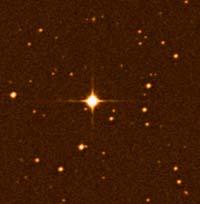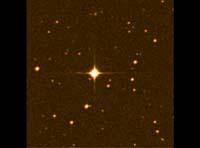Scientists, person
2010/10/23 Galarraga Aiestaran, Ana - Elhuyar Zientzia
The exoplanet called Gliese 581g, called exoplanet to planets outside the solar system, immediately became the protagonist of the major media titles. It could be the substratum of extralien life! The home of our distant neighbors! In addition to giving title, many media outlets, based on the words of astronomers, extensively or briefly exposed the characteristics of the exoplanet and, above all, highlighted their similarities with Earth.

The image is the star Gliese 581. That's sure. However, it is uncertain that in its environment there is an exoplanet similar to that of the Earth. (Photo: ESO))
Undoubtedly, the subject is attractive, and while some gave reasonable explanations, ’ what are the exoplanets, how they are detected, what characteristics have to have an exoplanet to create life in the same –, others began to discover how those living beings could be.
However, after a few days a silent news was opened: According to the latest data from the HARPS spectrograph, the exoplanet Gliese 581g does not exist. This was announced by astronomer Francesco Pepe who works with the HARPS. And Vogt and his team were based on data collected by the HARPS until 2008 to detect these exoplanets. They have now discovered that these data were not very reliable.
The official list of Gliese 581g exoplanets has already been removed and the other, Gliese 581f. The data may be reviewed and finally confirmed as stated by Vogt, but most experts believe that Vogt had advanced too much in the communication of the data, probably because he feared that Peper's team would advance him. Because it is not an honor to be the discoverer of the first exoplanet that can have life!
More examples in laboratories
However, there are not a few scientists. They are very smart, their neurons work faster and better than ours on topics they know and research. In the rest they are like the others. There are eleven examples in the history of science.
Without going further, a researcher at Michigan University, Veb Bhrund, is now tried for sabotaging the work of his colleague Heather Ames. Ames was conducting a doctoral study on cancer and was getting good results. A year ago, however, he noticed that rare things were happening: labels of cell cultures appeared mixed, proteins and antibodies that should not have existed... He suspected that someone sabotaged his job, but he never thought that his friend and colleague Bhfere could be the saboteur.
Believing suspicions were reasonable, two chambers were hidden by order of the laboratory director. In his images it can be clearly seen that Bhriguk manipulated the cultures of Ames. When she was interrogated by the police, Bhriguk acknowledged that she hindered Amés' work. He envies him. In fact, they did not work in the same field, so they did not compete. But he was jealous. They have now judged him and considered him guilty.
Scams, thefts, lies, envy, footprints… everything can be found among scientists. Like non-scientists.
Published in Gara

Gai honi buruzko eduki gehiago
Elhuyarrek garatutako teknologia




